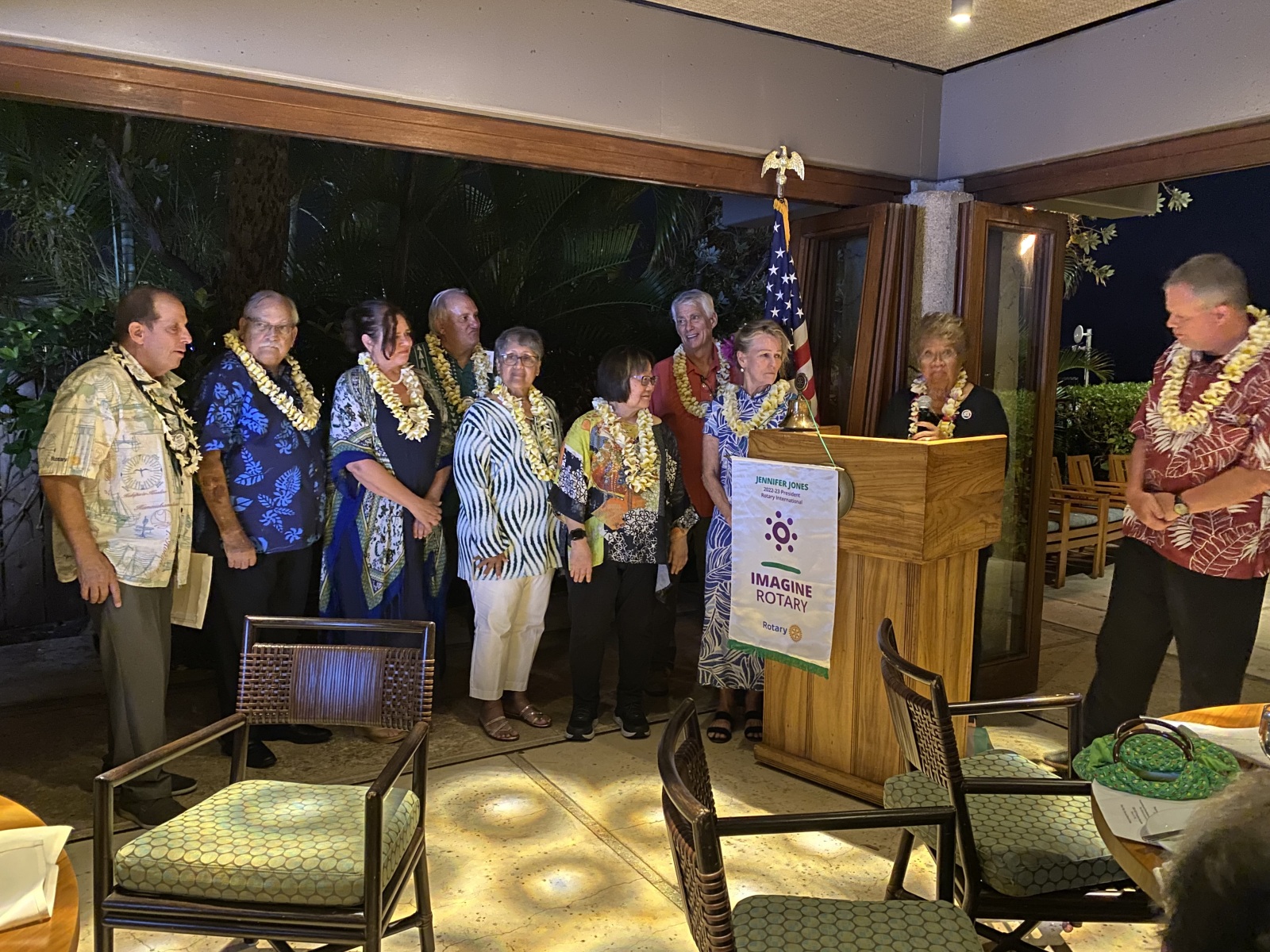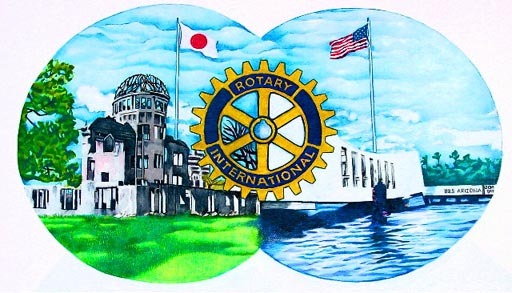Our History: Rotary Club of Pearl Harbor
The Rotary Club of Pearl Harbor was born as a provisional Rotary Club on May 21, 1950, through the foresight and hard work of three pioneers: David Moncrief, Jr., Harry Field, and James Orrick. David and Harry were members of the Rotary Club of Honolulu and employed in executive and administrative capacities at the Hawaiian Electric Company main office in Honolulu, and James was a Manager of the Ewa Plantation Company and a member of the Rotary Club of Wahiawa-Waialua.
Through the efforts of James Orrick, certain executives known for their interest in community affairs in Leeward Oahu were contacted to form the nucleus of the Rotary Club of Pearl Harbor as active charter members.
The Rotary Club of Pearl Harbor, as a provisional club, had during its early formative days the attention of Ezra Crane – a member of the Rotary Club of Maui and District Governor of District 100 now known as District 5000. Many other members of the Rotary Club of Honolulu also contributed their time and effort in bringing to a bunch of greenhorns their knowledge of what constituted Rotary and its goals.
Ten potential members got their initial indoctrination from the District Governor, Ez Crane, and sponsoring members Dave Moncrief, Jr. and Harry Field of the Rotary Club of Honolulu. District Governor Ez Crane, in his eloquent, fiery, dynamic and inimitable manner, gave those present an idea of all the Rotary intricacies, expectations and how to best serve the community and Rotary.
Upon formation as a provisional club, the club elected Officers and Directors.
The name “Rotary Club of Pearl Harbor” was suggested by Lt. Harold Hill better known as “Sam Hill.” Sam felt since the club’s boundaries lay on the fringes of Pearl Harbor, and the area was famous as the site for the beginning of World War II in the Pacific, it would add international esteem to the club. All agreed, and the name was unanimously selected and approved by the membership.
On June 14, 1950, the Rotary Club of Pearl Harbor was chartered by Rotary International under Charter No. 7562. On the evening of July 21, 1950, the club officially received its Charter from newly elected District Governor, Dr. Les Weight (a member of the Rotary Club of Hilo), at the Armed Forces Club House which was located on the mauka side of the Ala Wai Canal in Waikiki. This charter night turned into a wonderful evening of fun and was well attended by most of the members and their Rotaryanns, as well as all eight Rotary clubs in District 100.
Though an editor for the club’s newsletter was selected during the early days of the club, nothing was done or published until Ed Bryan took over the chore sometime in 1951 or 1952. The name and design of the Channel Marker, the club bulletin, and the usage of nautical terminology was the brainchild of Ed Bryan himself.
Many years and a lot of water has passed under the bridge since becoming a part of the Rotary movement. The club has progressed mightily from the early days when the original members were the greenest of greenhorns in their knowledge of the Rotary movement, thinking of it only as some kind of club or organization with the idea of service back of it.
One of the humorous episodes during the early beginning happened when as a chartered club was obliged to furnish Rotary International and District 100 certain dues and assessments on a per capita basis. As no monies were as yet collected from the membership, and no fines assessed, the treasury was “just plain broke.” Treasurer Karl Berg, having received and properly filled out the forms for the purpose, brought this problem to the attention of President Hansen. President Hansen then ordered Karl Berg to forthwith dispatch the necessary monies to the above agencies out of his own pocket.
The motion was immediately approved by the directors and Karl Berg was quite a few dollars out of pocket. He was properly reimbursed many months later when there were available funds in the treasury. Karl Berg was, however, acknowledged for “A Job Well Done.”
During the early years of the Rotary Club of Pearl Harbor, the Waimano Home, a Territory of Hawaii institution for the mentally retarded, was chosen as the club’s project.
This institution, lying within the club’s territorial limits, and now more correctly renamed the Waimano Hospital and Training School, is the home for about 850 mentally handicapped and deficient residents of all ages, racial extraction, social standing and sex. Many, if not most, are afflicted with physical disfigurements and/or deformities typical of those born with very low mentality.
In the latter part of 1957, board member, Manney Swerdlin, who was also the Director of the Community Avenue of Service, submitted a suggestion for recreation and therapeutic treatment of those suffering from muscular deformities and disorders. He felt that these patients would benefit by periods of immersion in the hot waters of a therapeutic pool.
The club wholeheartedly approved the suggestion, and Manney Swerdlin was appointed as General Chairman. Club members were not approached for donations but the amount received from the membership of 30 was far less than required. Other Rotary clubs in the District were approached to make this venture a district project, but most felt they had their own projects and could not accept. However, they agreed to assist in some form of monetary donation.
With a “Never Give Up” spirit, Manney Swerdlin next approached various business firms, construction companies, supply houses, sugar cane plantations and general contractors. In this pursuit, he convincingly sold Rotary’s theme of “Service Above Self” and these companies wholeheartedly donated or supplied materials, time, equipment, engineering services and labor at cut-rate prices.
In early 1958, the therapeutic pool was finally finished featuring hot and cold water. This pool was dedicated to the memory of David Moncrief, Jr. of the Rotary Club of Honolulu who had been so instrumental in forming, chartering and guiding the Rotary Club of Pearl Harbor.
The actual cost of the pool was $7,000.00 and it would have cost four times that figure if it had been contracted out. After dedication, it was presented to the Territory of Hawaii, now the State of Hawaii. And in order to cover all the costs and bills outstanding, the Rotary Club of Pearl Harbor sponsored a large Hawaiian luau under the general chairmanship and guidance of member Joe Keahiolalo. The luau was held at the Waimano Hospital grounds, and it netted enough money to meet all outstanding bills for the pool and luau.
The finalizing of the pool by no means ended the Waimano Hospital and Training School project. The club had an ongoing program of supplying certain equipment and services not furnished to the institution by the State of Hawaii. The gifts for the first couple of years consisted of TV sets, radios and recreational supplies such as baseballs, volleyballs and basketballs for the older residents; and playground equipment like swings and seesaws for the younger residents. These gifts enable the unfortunate ones to break the dreary monotony of their daily rigors.
On the recommendation of the administrator and superintendent of the institution, as well as its staff, the efforts were now redirected toward good quality wheelchairs and the sending of attendants to the mainland to learn new techniques of institutional care.
In addition to other gifts donated to Waimano Home, the club continued to donate boxes of new and clean used clothing and shoes to the residents since most of them came from families unable to properly provide such items.
This project will never be “completed” for the Rotary Club of Pearl Harbor expects to keep this as a pet project through thick and thin. This attitude is evident in the belief that Rotary is “Service Above Self” and “Service is My Business”, as well as exhibiting through these actions that “Somebody is Interested and Cares”, and that the members of the Rotary Club of Pearl Harbor will always be “Interested and Do Care.”
As a result of this major activity, the Rotary Club of Pearl Harbor was honored as the Rotary club with the outstanding project of District 5000 for the club year 1960.
Year after year, Pearl Harbor is recognized by all Rotary Clubs in District 5000 as the club with the best fellowship and outstanding programs.
The club has been honored by winning the Best Bulletin Award three times. (The first time was in 1952-53 under the editorship of Lyde McCleery, the second was in 1959-60 under the editorship of Ernie Ching, and the third was in 1981-82 under the editorship of Frank Koethe.)
Another highlight was when Ernie Ching was selected as the “Outstanding Rotarian of the Year of District 5000” in 1959-60; the first and only time such a contest was held to honor those who have contributed the most in service to his club.
Charter Members
- David Angel, Bank of Hawaii, Waipahu, Branch Manager
- James Atherton, Hawaiian Electric Power Plant at Waiau, Engineer
- Karl Berg, Housing Director, Ewa Plantation Company (Charter Treasurer)
- Edward Bryan, Housing Director, Ewa Plantation Company
- Dr. Dean Sunderson, Physician, Oahu Sugar Company, Waipahu
- Ernest Cling, Surveyor, Ewa Plantation Company
- R. Kirkwood Clarke, Administrator, Waimano Home and Hospital
- William Cockburn, Electrical Superintendent, Oahu Sugar Company, Waipahu
- George Fukuoka, Proprietor, Pearl City Tavern
- Warren Gibson, Industrial Engineer, Ewa Plantation Company
- Hans Hansen, Assistant Manager, Oahu Sugar Company, Waipahu (Charter President)
- Lt. Harold Hill, Hickam Air Force Base, C.O. of the Civil Air Patrol (Charter Secretary)
- Lt. Curtis Iaukea, Honolulu Police Department, C.O. Pearl City Substation (Charter Sergeant-at-Arms)
- Bert Johnston, Mill Superintendent, Oahu Sugar Company, Waipahu (Charter Director)
- Donald McLean, Engineer, Pearl Harbor Shipyard (Charter Director)
- Lyde McCleery, Mechanical Engineer, Ewa Plantation Company
- Halfred McKeever, Hydraulic Engineer, Oahu Sugar Company, Waipahu
- Dr. Garton Wall, Physician, Ewa Plantation Company
- Frank Wiley, Factory Superintendent, Ewa Plantation Company (Charter Vice President)
- Dan Yonemori, Manager, Ewa Super Market, Ewa

All are welcome in Rotary.
Rotary club membership represents a cross-section of the community’s business and professional men and women. The world’s Rotary clubs meet weekly and are nonpolitical, nonreligious, and open to all cultures, races, and creeds.


